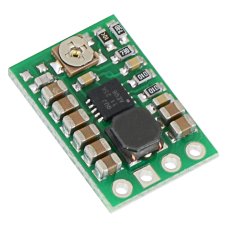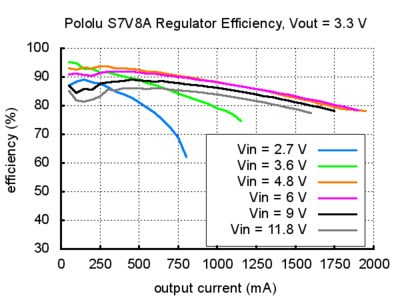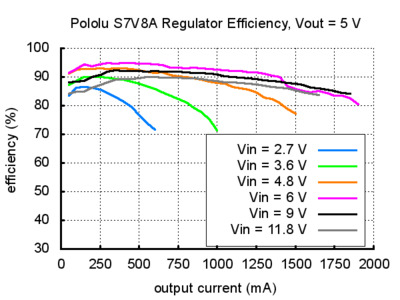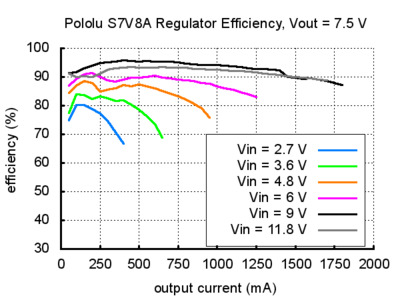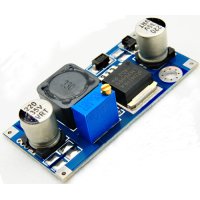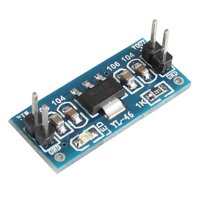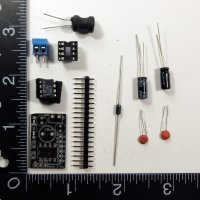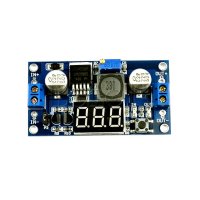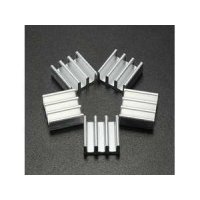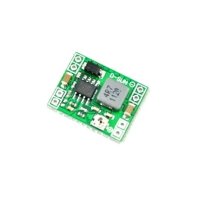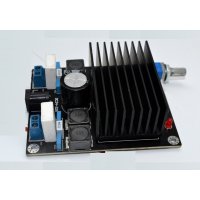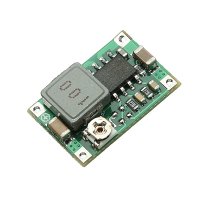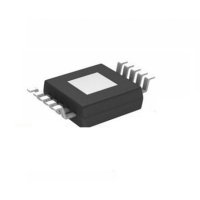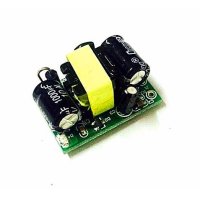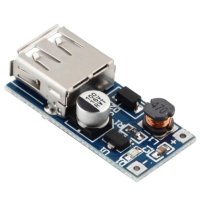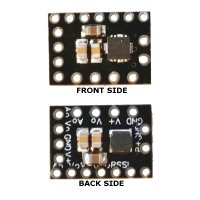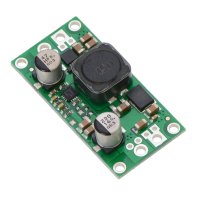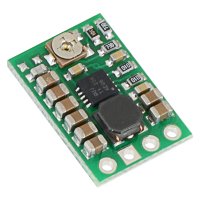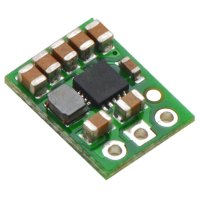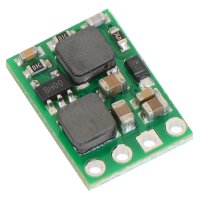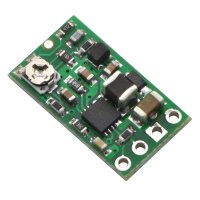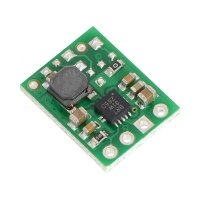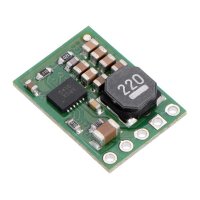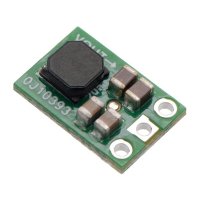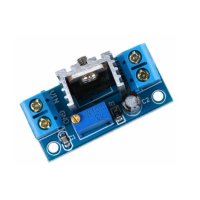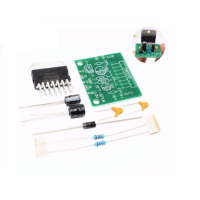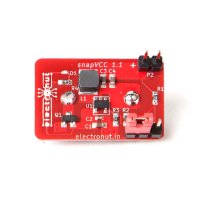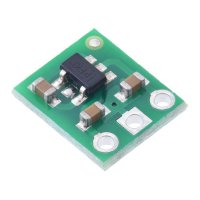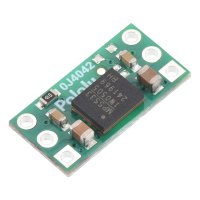The S7V8A switching step-up/step-down regulator efficiently produces an adjustable output between 2.5 V to 8 V from input voltages between 2.7 V and 11.8 V. Its ability to convert both higher and lower input voltages makes it useful for applications where the power supply voltage can vary greatly, as with batteries that start above but discharge below the regulated voltage. The compact (0.45″ × 0.65″) module has a typical efficiency of over 90% and can deliver 500 mA to 1 A across most combinations of input and output voltages.
The Pololu step-up/step-down voltage regulator S7V8A is a switching regulator (also called a switched-mode power supply (SMPS) or DC-to-DC converter) that uses a buck-boost topology. It takes an input voltage from 2.7 V to 11.8 V and increases or decreases the voltage to a user-adjustable output between 2.5 V and 8 V with a typical efficiency of over 90%. The input voltage can be higher than, lower than, or equal to the set output voltage, and the voltage is regulated to achieve the set output voltage.
This flexibility in input voltage is especially well-suited for battery-powered applications in which the battery voltage begins above the desired output voltage and drops below the target as the battery discharges. Without the typical restriction on the battery voltage staying above the required voltage throughout its life, new battery packs and form factors can be considered. For example:
- A 4-cell battery holder, which might have a 6 V output with fresh alkalines or a 4.0 V output with partially discharged NiMH cells, can be used with this regulator to power a 5 V circuit.
- A single lithium-polymer cell can run a 3.3 V device through its whole discharge cycle.
- A disposable 9 V battery powering a 5 V circuit can be discharged to under 3 V instead of cutting out at 6 V, as with typical linear or step-down regulators.
In typical applications, this regulator can deliver up to 1 A continuous when the input voltage is higher than the output voltage (stepping down). When the input voltage is lower than the output voltage (stepping up), the available current decreases as the difference between the voltages increases; please see the graphs at the bottom of this page for a more detailed characterization. The regulator has short-circuit protection, and thermal shutdown prevents damage from overheating; the board does not have reverse-voltage protection.
This regulator is also available with a fixed 3.3 V output or a fixed 5 V output.
Features
- Input voltage: 2.7 V to 11.8 V
- Output voltage adjustable from 2.5 V to 8 V
- Typical continuous output current: 500 mA to 1 A across most combinations of input and output voltages (Actual continuous output current depends on input and output voltages. See Typical Efficiency and Output Current section below for details.)
- Power-saving feature maintains high efficiency at low currents (quiescent current is less than 0.3 mA)
- Integrated over-temperature and short-circuit protection
- Small size: 0.45″ × 0.65″ × 0.1″ (11 × 17 × 3 mm)
- Complete schematic provided
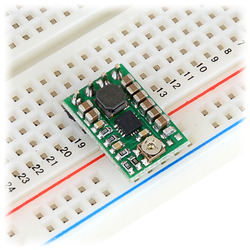 |
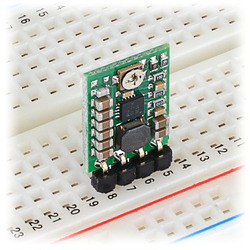 |
Using the Regulator
During normal operation, this product can get hot enough to burn you. Take care when handling this product or other components connected to it.
Connections
The step-up/step-down regulator has four connections: shutdown (SHDN), input voltage (VIN), ground (GND), and output voltage (VOUT).
The SHDN pin can be driven low (under 0.4 V) to power down the regulator and put it in a low-power state. The quiescent current in this sleep mode is dominated by the current in the 100k pull-up resistor from SHDN to VIN. With SHDN held low, this resistor will draw 10 µA per volt on VIN (for example, the sleep current with a 5 V input will be 50 µA). The SHDN pin can be driven high (above 1.2 V) to enable the board, or it can be connected to VIN or left disconnected if you want to leave the board permanently enabled.
The input voltage, VIN, should be between 2.7 V and 11.8 V. Lower inputs can shut down the voltage regulator; higher inputs can destroy the regulator, so you should ensure that noise on your input is not excessive, and you should be wary of destructive LC spikes (see below for more information).
The output voltage, VOUT, is determined by the trimmer potentiometer position. See the Setting the Output Voltage section below for details.
The four connections are labeled on the back side of the PCB, and they are arranged with a 0.1″ spacing along the edge of the board for compatibility with standard solderless breadboards and perfboards and connectors that use a 0.1″ grid. You can solder wires directly to the board or solder in either the 4×1 straight male header strip or the 4×1 right-angle male header strip that is included.
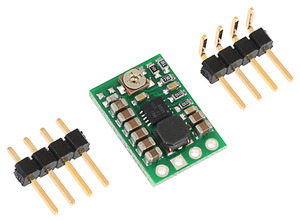 |
Setting the Output Voltage
The output voltage can be measured using a multimeter. Turning the potentiometer clockwise increases the output voltage. The output voltage can be affected by a screwdriver touching the potentiometer, so the output measurement should be done with nothing touching the potentiometer.
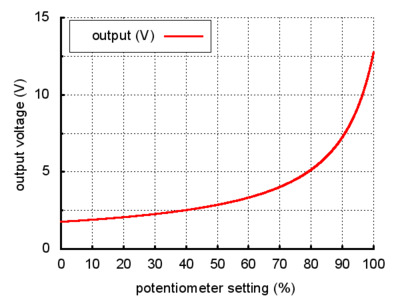 |
|
Output voltage settings for the Pololu step-up/step-down voltage regulator S7V8A. |
|---|
Please note that the output voltage can be set below 2.5 V at the low end of the potentiometer’s range and above 8 V at the high end. While this is not likely to damage the regulator, it might not work reliably or its output could become unstable when the output voltage is not within the recommended 2.5-8 V range. In addition, the potentiometer has no physical end stops, which means that the wiper can be turned 360 degrees and into an invalid region in which the output voltage is set to approximately 0.5 V.
The output voltage can be up to 3% higher than normal when there is little or no load on the regulator. The output voltage can also drop depending on the current draw, especially when the regulator is boosting a lower voltage to a higher one (stepping up), although it should remain within 5% of the set voltage.
Typical Efficiency and Output Current
The efficiency of a voltage regulator, defined as (Power out)/(Power in), is an important measure of its performance, especially when battery life or heat are concerns. As shown in the graphs below, this switching regulator has an efficiency between 80% to 95% for most applications. A power-saving feature maintains these high efficiencies even when the regulator current is very low.
The maximum achievable output current of the board varies with the input voltage but also depends on other factors, including the ambient temperature, air flow, and heat sinking. The graph below shows output currents at which this voltage regulator’s over-temperature protection typically kicks in after a few seconds. These currents represent the limit of the regulator’s capability and cannot be sustained for long periods, so the continuous currents that the regulator can provide are typically several hundred milliamps lower, and we recommend trying to draw no more than about 1 A from this regulator throughout its input voltage range.
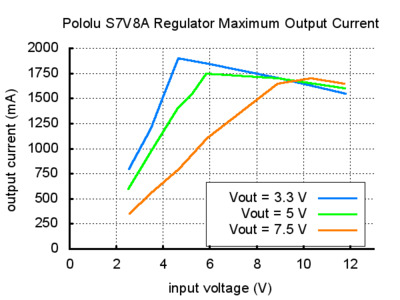 |
LC Voltage Spikes
When connecting voltage to electronic circuits, the initial rush of current can cause voltage spikes that are much higher than the input voltage. If these spikes exceed the regulator’s maximum voltage, the regulator can be destroyed. If you are connecting more than about 9 V, using power leads more than a few inches long, or using a power supply with high inductance, we recommend soldering a 33 μF or larger electrolytic capacitor close to the regulator between VIN and GND. The capacitor should be rated for at least 16 V.
Dimensions
| Size: | 0.45″ × 0.65″ × 0.1″1 |
|---|---|
| Weight: | 0.6 g1 |
General specifications
| Minimum operating voltage: | 2.7 V |
|---|---|
| Maximum operating voltage: | 11.8 V |
| Maximum output current: | 1 A2 |
| Minimum output voltage: | 2.5 V |
| Maximum output voltage: | 8 V |
| Reverse voltage protection?: | N |
| Maximum quiescent current: | 0.3 mA3 |
Identifying markings
| PCB dev codes: | reg09b |
|---|---|
| Other PCB markings: | 0J7031 |
Notes:
- 1
- Without included optional headers.
- 2
- When stepping down; current available when stepping up depends on input and output voltages (over 500 mA in most configurations).
- 3
- While enabled (SHDN = HIGH) with no load. Actual quiescent current depends on input and output voltages.
-
File downloads
- Pololu Step-Up/Step-Down Voltage Regulator S7V8x schematic diagram (192k pdf)
- Printable schematic diagram for the S7V8x family of Pololu step-up/step-down voltage regulators: S7V8A, S7V8F3, and S7V8F5.
- Texas Instruments TPS6306x regulator datasheet (2MB pdf)
- Step-Up/Step-Down Voltage Regulator S7V8x drill guide (22k dxf)
- This DXF drawing shows the locations of all of the board’s holes.
| Electrical Specifications | |
| Output Voltage | Minimum output voltage:2.5 V, Maximum output voltage:8 V |
| Output Current | 1A |
| Minimum Operating Voltage | 2.7 V |
| Maximum Operating Voltage | 11.8 V |
| Physical Attributes | |
| Weight | 0.6g |
| Dimensions | 0.45″ × 0.65″ × 0.1″ |
| Additional Information | |
| Warranty | |
Pololu 2118 Adjustable Step-Up/Step-Down Voltage Regulator S7V8A
- Brand: Pololu
- Product Code: Pololu-Adjustable-Step-Up-Down-S7V8A
- Reward Points: 6
- Availability: In Stock
- रo 628.00
-
रo 602.00
- Price in reward points: 628
-
- 25 or more रo 600.00
- 47 or more रo 595.00
- 96 or more रo 573.00
- 250 or more रo 548.00
Related Products
LM2596 DC to DC Step Down Adjustable Power Supply Module
Features:Adjustment method: first correct input power (between 4.5-50V) then multimeter to monitor t..
रo 90.00 रo 165.00
AMS1117 - 3.3V Power Supply Module
Key Features Input: DC 4.5V--7V Output: 3.3V, 800mA (load current can not exceed 800ma) Dual..
रo 30.00 रo 40.00
AMS1117 - 5V Power Supply Module
Key Features 1.Input: DC 6V - 12V 2.Output: 5.0V (+-0.05v error), 800mA (load current can no..
रo 102.00
Boost Kit
The Boost Shield Kit allows you to use supply voltages under 5v with the Digispark development board..
रo 220.00 रo 1,580.00
LM2596 DC to DC Step Down Module + LED Voltmeter
LM2596 Power Step-down Module DC 4.0~40 to 1.3-37V Adjustable + Voltmeter LED Display Feat..
रo 250.00 रo 485.00
Heat Sink - Aluminum with Glue (11mm)
These are high quality heat sink with heat conduction glue that can be used for dissipating the heat..
रo 13.00
XM1584 Ultra-Small Size DC-DC Step-Down Power Supply Module
XM1584 Ultra-small size DC-DC step-down 3A adjustable power supply module. Features and Specific..
रo 81.00
Amplifier Board TDA7498 100W+100W Class D
TDA7498 is 100W +100 W amplifier, using support monolithic integrated analog, logic and high pressur..
रo 1,678.00
DSN Mini 360 DC Adjustable Step Down Power Supply Module
Mini DC Adjustable Power Supply Buck Module Step Down Module Specifications: Modul..
रo 115.00 रo 130.00
Voltage Converter TPS5401DGQT 3.5V-42Vin,0.5A Step Down SWIFT
Voltage Converter TPS5401DGQT 3.5V-42Vin,0.5A Step Down SWIFT Specifications: Topology :..
रo 150.00
AC-DC Power Supply Buck Converter Step Down Module 5V 700mA
This power supply has the temperature protection, over current protection and short circuit protecti..
रo 140.00 रo 230.00
DC-DC Adjustable Step-up Power Converter Board 0.9V - 5V
DC-DC Adjustable Step-up Power Converter Board 0.9V - 5V Features Input volta..
रo 77.00
Regulator Step-up/ Step-Down - 5V
High precision, special design for micro FPV, easy soldering like a distribution board. No moto..
रo 1,216.00 रo 1,267.00
Pololu 2574/2575/2576/2577/2572/2573 5V/ 6V/ 9V/ 12V/ 4-12V/ 9-30V Step-Up/Step-Down Voltage Regulator S18V20F5/ 6/ 9/ 12/ ALV/ AHV
This powerful S18V20F5 S18V20F6 S18V20F9 S18V20F12 step-up/step-down regulator efficiently produces ..
रo 2,092.00 रo 2,179.00
Pololu 2122 3.3V Step-Up/Step-Down Voltage Regulator S7V8F3
The S7V8F3 switching step-up/step-down regulator efficiently produces a fixed 3.3 V output from inpu..
रo 602.00 रo 628.00
Pololu 2123 5V Step-Up/Step-Down Voltage Regulator S7V8F5
The S7V8F5 switching step-up/step-down regulator efficiently produces a fixed 5 V output from input ..
रo 602.00 रo 628.00
Pololu 2119 5V Step-Up/Step-Down Voltage Regulator S7V7F5
The S7V7F5 switching step-up/step-down regulator efficiently produces 5 V from input voltages betwee..
रo 527.00 रo 549.00
Pololu 2095 / 2096 / 2121 DC-DC Step Up Power Converter Booster - MT3608
This switching regulator uses the SEPIC topology to produce 5 V/9 V/12 V from input voltages between..
रo 844.00 रo 879.00
Pololu 2120 Adjustable Step-Up/Step-Down Voltage Regulator S8V3A
This switching regulator uses the SEPIC topology to provide a regulated output voltage that can be h..
रo 747.00 रo 778.00
Pololu 2561/2562 3.3/ 5V Step-Up Voltage Regulator U1V11F3/ U1V11F5
This compact (0.45″×0.6″) U1V11F3/ U1V11F5 switching step-up (or boost) voltage regulator efficientl..
रo 527.00 रo 549.00
Pololu 2830 / 2831 / 2832 / 2833 / 2834 1A Step-Down Voltage Regulator D24V10F3/ 5/ 6/ 9/ 12
The compact (0.5″ × 0.7″) D24V10F3/ 5/ 6/ 9/ 12 synchronous buck voltage regulator takes an input vo..
रo 754.00 रo 786.00
Pololu 2836 5V Step-Up/Step-Down Voltage Regulator S9V11F5
The S9V11F5 switching step-up/step-down regulator efficiently produces 5 V from input voltages betwe..
रo 679.00 रo 707.00
LM317 DC-DC Converter Buck Step Down Voltage Regulator
LM317 DC-DC Converter Buck Step Down Voltage Regulator Features: 1.Output ..
रo 90.00
snapVCC
Many circuits require a regulated 3.3 or 5 volt power supply. The 9V battery is an easily available ..
रo 1,801.00
Pololu 2839 Charge Pump Voltage Inverter: 1.8-5.3V, 60mA
This board is a charge pump voltage inverter that converts an input voltage between 1.8 V and 5.3 V ..
रo 224.00 रo 233.00
Pololu 5384 Isolated DC-DC Power Module, MIE1W0505BGLVH, 5V/3.3V, 200mA
This power module provides regulated, galvanically isolated DC-to-DC power. It is set to 5 V out by ..
रo 376.00 रo 391.00
Tags: Pololu, Adjustable, Step-Up, Step-Down, Voltage, Regulator, S7V8A

